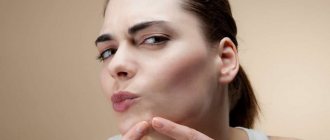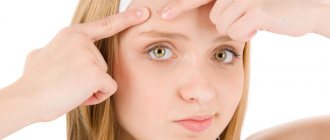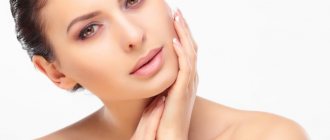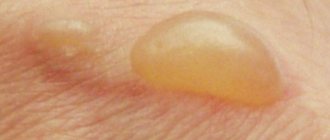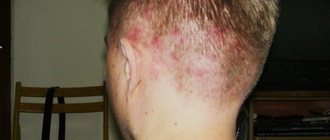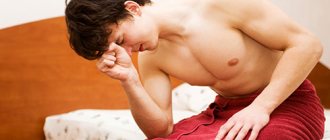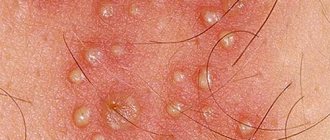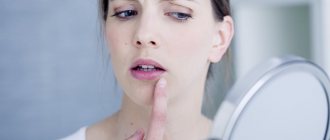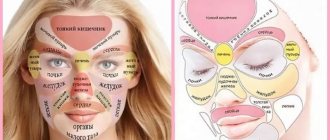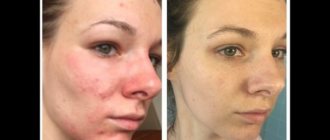Acne and peeling of the skin on the face are quite common. Dry skin is caused by a lack of moisture, and various rashes can occur due to diseases. In addition, acne often forms due to improper care of the facial epidermis. A doctor can help you figure out what caused the problem, carry out the required diagnostic measures and then prescribe the correct treatment.
How is peeling skin related to the appearance of acne?
Rough areas on the face are most often associated with a lack of vitamins or may be a sign of a serious disease of the internal organs, so you should not ignore the problem. If at the same time as dryness and peeling there is a rash on the face, then you cannot do without the advice of a specialist.
Incorrect acne treatment
Usually people with problem skin try to cope with acne and peeling of the face on their own, and for this they select the wrong medications. Treatment is prescribed only after determining the causes of the rash and skin type. For example, antibiotic products are not suitable for all types of acne. Sometimes you will need two types of medications to eliminate peeling and rashes on your face. You can't do without changing your diet.
Skin types and how to recognize them
Of course, to accurately determine your skin type, you need to consult a cosmetologist or dermatologist. The type of skin is affected by the work of the sebaceous glands and the amount of moisture in it. Often the skin changes after moving to another area, changing climate and diet. The normal type is considered the healthiest and most problem-free, but it is also quite rare. This type is most often found in babies with a delicate pink tint and no pimples or roughness. There are three main types of leather:
- dry
- fat
- combined.
A sign of dry skin is narrow pores and frequent irritation. It is the thinnest of all types and ages faster. Sudden changes in temperature, wind, and sun rays almost immediately cause peeling and redness. Natural dryness often causes the skin to become rough in certain areas.
Women with combination skin have dry and flaky areas along with an oily sheen in the nasolabial triangle or forehead, where there are blackheads or pimples. Oily skin can be identified by the shine of the face, enlarged pores and comedones. It is least likely to accumulate dead skin cells, but it is characterized by pimples and blackheads. As a rule, oily skin type is characteristic of young women under the age of 35.
Watch the video Determining your skin type for further care
Using the wrong cosmetics
The skin needs intensive hydration during treatment. Often the use of conventional cosmetics does not produce any results, since flaky skin requires special care. Without proper cleansing, pores become clogged due to a large number of dead cells and rashes appear again and again. Soap should not be used to cleanse the skin, because it dries out the face too much. You also need to forget about alcohol-containing lotions or tonics during treatment, which will further damage the skin.
How to get rid of the problem?
Drug therapy
If a person with acne is caused by diseases, treatment involves the prescription of medications that will eliminate the pathology. In addition to these remedies, medications are also prescribed that restore the top layer of the skin and also get rid of roughness. He often resorts to using a medicine called Dexpanthenol. For the same purposes, Bepanten can be used, which is supplied to pharmacy chains in the form of a gel or cream for external use.
ethnoscience
If a pimple or peeling occurs on the face, you can resort to the help of healers’ prescriptions, but this can only be done after consultation with a dermatologist, so as not to further harm the skin. To eliminate keratinized areas of the epidermis, it is recommended to use the following product:
- Oatmeal flakes in the amount of 2 tablespoons are mixed with the same volume of honey.
- Mix thoroughly and apply to the skin of the face.
- Massage the epidermis for 2 minutes.
- Wash off with cool running water.
- Apply nourishing or moisturizing cream.
Flaky skin on the face can be cured with the help of this mass:
- Mix cottage cheese and fat sour cream in equal quantities.
- Cleanse the epidermis with a cosmetic cleanser.
- Treat your face with a mask.
- Wait half an hour.
- Rinse with water.
Cosmetological treatment
The laser will deeply clean and get rid of the problem.
One of the most popular methods of getting rid of peeling and acne is laser therapy. The cosmetologist precisely targets problem areas with a laser beam, which helps penetrate the deep layers of the epidermis and kill bacteria. The technique makes it possible to prevent the subsequent appearance of new rashes, narrow pores and eliminate scars that remain from past pimples. Mostly 2-3 sessions of this manipulation are required.
One of the main advantages of laser therapy is painlessness.
Ultrasound treatment is also used, but it is effective only in situations where there are no more than 10 pimples on the face. During the manipulation, the physician exfoliates the keratinized areas of the epidermis using a spatula called an ultrasonic scrubber. The procedure makes it possible to eliminate clogging of pores, improves complexion, makes the skin silky and eliminates pimples.
Internal reasons
The condition of the skin depends on its type, nutrition, daily care and many other reasons. Among the internal factors that lead to dryness are:
- taking medications,
- unhealthy diet
- disruption at the hormonal level,
- allergy,
- lack of vitamins and minerals in the body.
Low levels of vitamin A usually lead to a build-up of dead scales on the face, as well as skin inflammation in the form of pustules and pimples. Sometimes peeling is a normal reaction of the body to taking certain medications. After completing the course of treatment, the skin returns to normal. Malfunctions of the thyroid gland and the female reproductive system lead to hormonal imbalance, which immediately affects rashes on the face.
Often, the deterioration of the skin condition is caused by allergies, but it can be not only to food, pollen, but also due to unnatural cosmetics. In the case of high-quality cosmetics, skin care may be incorrectly selected. Diseases that are accompanied by peeling include ichthyosis, erythema, dermatitis, systemic lupus erythematosus, fungal infection, psoriasis and others.
In case of severe itching along with rough areas on the face, you should immediately contact a dermatologist.
Folk remedies
To treat and prevent peeling, it is useful to carry out gommage. To complete it you need:
- Steam the skin with a warm compress or hold your face over the steam.
- Apply the medicinal composition.
- After 10-15 minutes, remove the resulting film and wash your face with warm water.
Gommage can be done according to different recipes. Gommage made from oatmeal is widely popular. To prepare it, you need to mix equal amounts of ground flakes, honey and olive oil. You need to add the yolk to this mixture, after which the mass must be thoroughly mixed and applied to the face. Those with oily skin are advised to add a few drops of lemon juice to the composition.
To increase the effectiveness of the product, you can supplement it with corn grits or granulated sugar.
A simpler gommage recipe involves using white bread. A slice of this product is filled with water or milk. When it swells, the composition must be stirred until smooth. It should be applied to the face and washed off with water after 15 minutes.
Gommage from coffee grounds can also help get rid of flaking. To prepare it, you only need to grind the coffee beans and brew a drink from them. The thickener should be drained, applied to the face and massaged with light movements. After 15 minutes, the composition is washed off with water.
Other masks that include honey, baked onions and fresh cucumbers with sour cream are also widely used.
External reasons
Any change in the condition of the skin is associated with the influence of internal and external factors. It is much easier to deal with external influences on the skin than with those reasons that affect the functioning of internal organs.
- environment,
- poor quality cosmetic products,
- sudden climate change,
- aggressive facial cleansers.
When choosing cosmetics, you should always take into account your skin type, and also remember to read the composition of the cream or lotion. Before going outside, you need to additionally protect your skin from the sun and wind.
Recognizing diseases associated with peeling skin
Allergy
Ichthyosis
Systemic lupus erythematosus
Dermatitis
Erythema
Skin peeling depending on age
There are age-related factors that affect the condition of the skin.
Peeling in men
Typically, males are much less likely to suffer from facial peeling. The main source of problems is the wrong means for washing and skin care, an allergic reaction of the body, and infectious processes. Men often choose the simplest skin care product, that is, soap, which dries out the face greatly. In this case, it is better to immediately abandon aggressive cleansers and use a mild lotion or gel for daily cleansing.
Skin in teenagers
A child’s body changes and grows rapidly during adolescence, so it often lacks beneficial vitamins due to poor food. A lack of protein in the diet will lead to peeling skin and various pimples. Hormonal changes also make themselves felt in the form of rashes on the face. During this period, parents need to carefully monitor their children’s nutrition, and also use only high-quality preparations intended for teenagers for facial care.
Peeling in children
In childhood, peeling is most often caused by a reaction of the skin to external irritants, for example, care products, wind, frost, or taking medications. Children's skin is very sensitive, so you will need special products to care for it. It is important to first determine the cause of the skin problem with the help of a doctor.
To identify other rashes in your child, read this article.
Why does women's skin peel?
In most cases, females suffer from facial peeling. The main reason is lack of moisture, improper care, and poor nutrition due to constant diets. Experimenting with cosmetics also harms the skin. You need to choose cleansers and moisturizers strictly according to your skin type.
Prevention
To prevent peeling and acne on the skin, doctors recommend that patients first of all eat a healthy and balanced diet. A large number of foods containing fiber, microelements and vitamins should be added to the menu. Protein is also important for the healthy functioning of the body, which can be obtained from lean meats, eggs, and legumes. The diet should be enriched with vegetables and fruits, fish, and herbs.
An active lifestyle and frequent walks in the fresh air will also help reduce the likelihood of rashes. Doctors advise to engage in gentle sports. In addition, proper care will help reduce the likelihood of developing skin problems. When choosing cosmetic products, it is important to pay attention to the label, which indicates for what type of epidermis this product can be used. You should not forget about the composition, which should be natural for sensitive skin and allergic reactions.
Which doctor should I contact?
Peeling is an excess of dead cells, but the causes of this condition can be completely different. Depending on what caused acne and excess dead cells on the face, people turn to a different specialist. First of all, you need an examination by a dermatologist who will determine the type of skin disease. If the cause is internal disorders or peeling appears due to allergies, the patient will be referred to an allergist.
In the case of psoriasis, herpes zoster and other skin problems that affect the nervous system, you will need to consult a neurologist. If, in addition to peeling, there are painful pustular formations on the face, a surgeon will help eliminate the problem. Sometimes the cause of the disease is an infection in the body, so you need to contact an infectious disease specialist.
Symptoms
Since skin changes are not always associated with local processes, to determine the cause of acne you will have to undergo a comprehensive examination. The first stage will be a medical examination, on the basis of which a preliminary diagnosis is made. The specialist interviews the patient and identifies objective signs of pathology present in him.
Comedones
Comedones are considered a type of acne. These are small papules that occur when skin pores are blocked by fatty deposits and horny masses. Closed comedones are white, while open comedones are black. The former, unlike the latter, are often subject to inflammation with the further formation of nodes and pustules.
When pressed, thick contents are released from the comedones. They are localized in places rich in sebaceous glands. On the face these are the nose, forehead, chin and cheeks. In addition, similar dry pimples are detected on the back, but sebaceous plugs there, of course, are not so noticeable.
Neurodermatitis
People with an allergic predisposition often develop atopic dermatitis or neurodermatitis. This is a chronic disease that is characterized by the appearance of papular rashes accompanied by intense itching. They appear on unchanged skin or cover slightly hyperemic areas.
Against the background of dry skin, due to hyperkeratosis processes, scales and cracks appear, and the natural pattern (lichenification) intensifies. The rash can be localized on any part of the body, but most often the face, neck, and large folds are affected. Papules can merge with each other, forming continuous infiltrative foci.
In addition to dermatological changes, neurodermatitis is also characterized by systemic disorders. They are mainly neurotic in nature:
- Sleep disturbance.
- Emotional lability.
- Irritability.
There are also vasomotor disorders. At the local level, they are represented by white dermographism, but often there is even a decrease in blood pressure caused by autonomic dysregulation.
Dry skin with acne occurs with neurodermatitis, when the rash is accompanied by intense itching.
Follicular hyperkeratosis
With follicular hyperkeratosis, the stratum corneum of the epidermis thickens, causing small pimples to appear against the background of rough and rough skin. The nodules are located at the base of the hair follicles and are surrounded by a red rim. Mostly, such pimples are localized on the arms and thighs, forming a picture of “goose bumps”.
The generalized form of the disease is accompanied by extensive damage to the trunk and limbs. The skin of the face is sometimes also involved in the pathological process - then the rash has to be distinguished from acne. With hyperkeratosis, unlike acne, pimples on dry facial skin will be the same size and rough.
Molluscum contagiosum
The disease, known as molluscum contagiosum, is viral in origin. A person becomes infected through sexual or household contact. The latter is most typical for children. Small papules appear on the skin, no different in color from the surrounding skin or slightly pinkish. They have a depression in the center, and when pressed, a curd-like plug is released.
Dry pimples on the body in adults, which are a sign of molluscum contagiosum, are usually localized in the abdomen and thighs, but in children they can appear on other areas, including the face. The disease does not bring any subjective sensations; sometimes a slight itching is possible. The prognosis is favorable; it takes from 2 weeks to several years for symptoms to disappear on their own.
Choice of treatment method
Any method of eliminating acne and flaking involves regular and long-term implementation of skin-beneficial procedures. Various masks and peelings will help restore skin health. For peeling, acids are most often used, which carefully dissolve the upper stratum corneum. It is better to avoid scrubs as you can spread the disease to healthy areas.
Traditional treatment
When simple moisturizing is not able to cope with peeling, the doctor prescribes special medications. Dexpanthenol is suitable, which will not only remove roughness, but will also help to quickly restore the top layer of skin. The next effective remedy is bepanthen in the form of a cream or lotion. Hydrocortisone ointment gives quick results. It is applied once a day for two weeks.
Folk remedies
Traditional recipes suggest using natural moisturizing ingredients. Olive oil and egg yolk are suitable for masks. Crushed oatmeal is combined with honey to create an effective mixture for gently cleansing the skin. Masks made from sour cream, cottage cheese, and cucumber moisturize the face well. For example, combine fatty methane with cottage cheese in equal proportions and apply to a cleansed face for 15-20 minutes.
Choose a mask for your problem here.
Drugs
If the skin begins to peel off, you need to consult a cosmetologist. As a rule, doctors in such cases prescribe dexpanthenol preparations. This substance improves the condition of the epidermis in almost all aspects - from accelerating regeneration to restoring immunity. Dexpanthenol is used in the following forms:
- Panthenol. It is a spray that is very easy to use. The product should be applied to a cotton pad and spread over the face with light movements. After 10 minutes, remove any remaining drug using a cotton pad. This should be done a maximum of 4 times a day.
- Bepanten. It is recommended to use it exclusively in cream form, as the ointment tends to clog pores. The product is applied to the face in the same way as any other cream.
In most cases, you need to use a moisturizer along with dexpanthenol. If the problem is not too serious, you can do without synthetic drugs altogether.
Expert advice
To avoid unpleasant flaking, pimples and dry skin, follow these professional recommendations:
- Every day the skin needs proper cleansing. In the morning and before going to bed, you need to wash your face with a special soft gel or lotion.
- You cannot do without regular cleansing masks and cosmetic peelings. If it is not possible to do such procedures in the salon, there are many recipes for independent use.
- After deep cleansing, you should not use a rough towel; it is better to take a regular soft napkin to remove excess moisture.
- During the treatment of peeling, you should not use cleansers with alcohol, because it causes dry skin and can aggravate the problem.
Uncontrolled use of medications leads to bad consequences, so it is better to first try a moisturizer, and if the problem persists, you should consult a doctor. If there is itching or pimples on the face along with peeling, then a visit to the doctor cannot be postponed. Timely medical care will restore beauty and health to the skin.
Cosmetology procedures
If your pimples itch and acne appears on your face, you should definitely visit a doctor. When the main reason is found out, you can make an appointment with a cosmetologist to undergo procedures aimed at cleansing the skin.
To remove skin unevenness and eliminate the consequences of a rash, various SPA procedures can be performed, for which salon cosmetics are used. When the full course of treatment is completed and the acne has decreased or has disappeared completely, you can undergo a peeling procedure.
You need to take care of acne-prone skin using high-quality cosmetics. It will help not only cleanse your facial skin, but also relieve itching.
If the red spots that appear on the face are flaky, but not itchy, it is worth going through several sessions of salon care: mechanical cleaning, biorevitalization, hardware massage, fruit peeling, cryotherapy, electrocoagulation, mesotherapy.
You must make an appointment after a preliminary consultation. To carry out procedures, it is necessary to take into account age, the degree of damage to the epidermis, and skin type.
